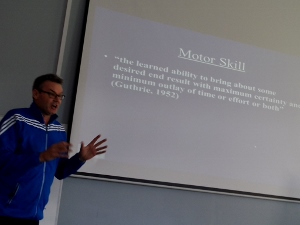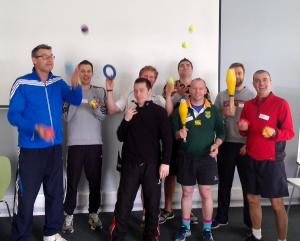How to acquire skill in strength and conditioning
“Skill learning isn’t just skill learning, it’s preparation”
 John Brierley in his skill acquisition lecture on our level 3 coaching strength and conditioning for sport course.
John Brierley in his skill acquisition lecture on our level 3 coaching strength and conditioning for sport course.
Ever see the 5 sets of 5 programme for squats, power cleans and bench press? Dull as dishwater!
If we want our athletes to develop, we need to challenge their skill. If we fail to do that they get bored.
John’s theme was how can we make ourselves redundant as coaches: “It’s not our responsibility to keep control of their learning.” Instead, we need to “Get people to be in love with the activity” and then that stands them in good stead later on.
That’s coaching. How do you coach in the gym? Is it just handing out sets and reps and increasing the weight?
Do you crank up the music to create “atmosphere” and remove the human contact between coach and athlete?
These were the questions John was asking us as coaches. If we are to be successful (and by that I mean getting our athletes performing in the arena) then we need to improve our coaching, including motor skill acquisition.
Motivation and motor skill acquisition go together

Juggling is fun
If we get the athlete motivated, then they are more likely to acquire the skill.
This comes down to structuring the practice well, using the right level of task difficulty and then using the correct cues and feedback.
We spent some time doing this as a group as John broke out his Mary Poppins bag of coaching aids.
We had to perform a juggling task, test it, then do 2 minutes of practice with some video feedback, rest, then practice more. We then retested at the end.
There was minimal chat, some cues such as “think drainpipe rather than teapot” and short focussed practice. The idea was that by looking at the video, and trying 1 or 2 cues, we could improve.
(Duncan proved to be a juggling whiz, so whilst we were dropping tennis balls, he was progressing from 2 to 3 balls, to mishaped objects, to juggling clubs: John was well prepared with stuff!).
This structure was similar to the micropractice work we did in December.
“People are never as physically tired as they are mentally“. We can give the athlete breaks in practice when the skill is hard to achieve. Rest them physically, but work on something else.
I apply this with athletes as just when they are looking comfortable or familiar it is time to move on (temporarily) to something else. Boredom sets in otherwise, and the learning stagnates.
Decision making counts
Skill rarely happens in isolation in sport. Instead, it is the decision making that counts. “Don’t take the decision making out of it“. Practice needs to be variable:
- Short, long or medium length.
- Shooting/ rehearsing dominant/ non-dominant.
- Slower vs faster.
- Change the environment and context.
As we set down our learning pattern, we won’t remember the rep, but we will remember the context in which we practiced.
- How do you structure your practice?
- Is it the same every time?
- Are your athletes getting better at some pre-programmed activities?
- How do you know if that can then be applied to the sport?
I left the course with a lot of questions I have to ask myself, and I was the lead tutor!
Summary
John’s wealth of experience working in football and athletics enabled him to share practical examples of challenges within teams and high pressure situations.
His approach of “how to get everyone working together” was insightful and useful for all the coaches.
“Less is more” seemed to be one of the themes of the course: simpler, more effective cues. Have fewer exercises, but coach them really well, and change the context and environment in which we practise them.
Marius and Andy had emphasised this on the first weekend of the course too.
The rest of the weekend was spent looking at how all the pieces of the puzzle fit together: planning the year, the month the week and the individual session.
I wanted the coaches to be asking the right questions of themselves and of their athletes; perhaps most importantly
How can I help my athletes improve their performance where it counts? The competitive arena.
If you would like to host a course at your school or club, please see what we offer here
Further reading

Hi James,
This was a very interesting part of the course, an area which I think a lot of S&C coaches don’t spend much time researching and reviewing….myself included. Some of the key take home messages I took from this lecture were:
Motor Skills don’t work in a vacuum, you have to develop them in a team environment.
Athletes need to work independently in the future, this is our long term goal.
If its decision making that counts then don’t take the decisions out of training
At the end of the session: what have you learnt? Where can you take this forward? What can we do now to get better?
Thanks for another great opportunity to learn from highly skilled coaches
Brett
Thanks Brett, you forgot to mention the speed and agility work which saw some new found skills on your part!
Hi James,
Thanks for another great weekend of learning.
I enjoyed mix of topics covered throughout the weekend and also the opportunity to hear experienced coaches present and/or be coached by them through taking part in their session(s).
Some key points I took away from the weekend are as follows:
The importance of adaptability:
Whether it be with regards to planning sessions, or to do with coaching, learning, training or practice all of these must be adaptable so that this allows us to train for a better situation.
The importance of feel as a reference point for correctness
It’s unlikely that athletes will remember the perfect rep, run or cut, but they will remember how it felt. Feel can be used as a reference point for correctness.
The importance of understanding and knowing your athlete(s)
It’s important to learn about your learners, as learners have different mind-sets. Not only this but better knowing your athlete(s) will help you know their other commitments e.g. school and sporting wise, this will help with planning training sessions and reduce the likelihood of overtraining.
When planning training think ‘Budget’:
By knowing the crux of your workout and/or tests this will help you get the most out of them
Thanks for taking the time and effort to set up and deliver the course. Much appreciated.
Ollie W
They say you can judge a man by the company he keeps. Well you can judge a course by the people who deliver the sessions. In the two weekends everyone who presented was clear, informative and made complex ideas simple to understand. Proof of people who had a strong grasp of their subject.
The other thing that struck me was the humility shown.
As a Level 3 course group I understood that we need to lean on each other more for support and shared info, point James strongly made. It is easy to let the weeks drift by as we all saw with the course work tasks for the month.
I am at that stage where I am processing and re-thinking my approach and delivery of sessions. I see this as part of the growth needed to develop the art of coaching and was a reason for signing up.
The Saturday and Sunday training sessions had a rational, that was tailored to individuals and challenged us. It is alright talking about something another to execute it and demonstrate. I have upped my training in the areas I am not strong in, rather than just doing the things I am better at.
I thank James for putting this together and giving us a direction where we can all develop into better coaches.
Mark Sheppard
Thanks Mark for your comments and also your input into the course. Really good to have everyone share, participate and challenge me!
Hi James,
I agree with the observations above which don’t need repeating here.
One thing that keeps coming back to me is introducing adversity into the training and taking ourselves and our athletes out of our comfort zone. John Brierley raised this in his presentation.
It is human nature to want your athletes to be a good reflection of your training. Which can lead to playing safe and over prescribing, taking away the skills the athlete needs to develop to cope with different environments, cultures, schedules, opponents etc.
In introducing stress as you would resistance loads the athlete will need to problem solve, adapt, fail and learn. James is doing this all the time in the sessions I have experienced with him and he will push you to raise your game, it is not comfortable but that’s performance, reaching beyond what you normally do.
Thanks James and everyone else on the Level 3 course.
Mark
Hi James,
Another challenging weekend, with tonnes of information now to sift through and look at implementing.
Challenge was one of the key words for me over the weekend, as coaches we need to create an environment where we constantly challenge our athletes to solve problems whether sport related or in the gym. This is something I try to do but need to be more creative in my approach at times.
When it comes to programming, you need to start with what is required by the sport not what is currently being practiced, to do this you need to analyse the sport thoroughly and work out what is required – the “nice v need”.
I found the practical aspect of the weekend really useful, it is always useful to observe others coach and see how they organise sessions and make a group session individualised to everyone, it is also good to be coached to improve my technique and to feel how tough others sessions are.
Duncan
[…] Motor skill learning in strength and conditioning […]